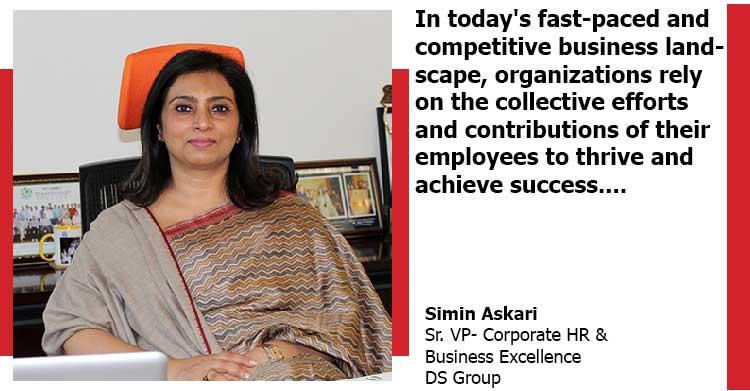How Leaders can handle underperforming employees? | Simin Askari | Sr. VP- Corporate HR & Business Excellence | DS Group

In today’s fast-paced and competitive business landscape, organizations rely on the collective efforts and contributions of their employees to thrive and achieve success. However, one of the most significant challenges that organizations often face is the issue of underperformance among their workforce. While it may seem like a minor setback at first glance, underperformance can have far-reaching implications that can negatively impact the organization’s bottom line, employee morale, and overall productivity. Underperformance manifests in various forms, including missed deadlines, subpar work quality, lack of engagement, and ineffective collaboration. When left unaddressed, these issues can snowball into larger problems that can impede progress and hinder organizational growth. Addressing underperformance in the workplace requires a multifaceted approach.
Effective leadership plays a pivotal role in fostering a culture of excellence, driving performance, and achieving strategic objectives. One of the most challenging aspects of leadership is managing underperformance among team members.
To manage this challenge, first and foremost, leaders must adopt a proactive approach to identifying and addressing underperformance. By staying vigilant and observant, early signs of underperformance can be detected and interventions can be done before the issues escalate. However, addressing underperformance requires more than just identifying problems.
A vital step towards the address involves private discussions with the employee. This confidential dialogue provides an opportunity to address concerns surrounding performance in a supportive and constructive manner. Effective communication is a two-way street, and it is crucial for a leader to actively listen to the employee’s viewpoint during these discussions. Demonstrating empathy and openness provides a safe space for the employee to express their concerns, challenges, and perspectives.
Listening to the employee’s input allows the leader to gain valuable insights into underlying issues or obstacles hindering performance. Rather than resorting to blame or criticism, a leader should focus on problem-solving and collaboration, seeking to uncover the root causes of the performance issue and develop effective solutions together with the employee. Sometimes an employee may be going through a personal problem, temporarily affecting his/her performance. And in such cases, having an empathetic and considerate approach may be all it takes to address the performance issue.
At times underperformance is also the result of a lack of clarity of expectations. Clarity is paramount when it comes to setting expectations and goals for performance improvement. Leaders should clearly articulate their expectations regarding work standards, behavior, and outcomes, leaving no room for ambiguity. When an employee is involved in the goal-setting process, s/he feels empowered to take ownership of their goals and succeed. Setting clear timelines for deliverables also helps the employee plan the work and at most times be able to deliver accordingly.
At times, an underperforming employee could benefit from supplementary measures such as tailored training, personalized mentoring, or targeted coaching sessions. Ensuring access to necessary resources, including advanced tools or technology, can significantly enhance the individual’s skill set and capabilities. Investing in the professional development of employees not only nurtures their growth but also fortifies the organization’s talent pool. This strategic investment in talent development not only addresses immediate performance concerns but also cultivates a more resilient and high-performing workforce, positioning the organization for sustained growth and competitiveness in the marketplace.
Leaders must embrace the reality that failures are an inevitable part of the journey toward success. By acknowledging and accepting failure as a natural aspect of growth and innovation, leaders create a culture that encourages risk-taking, experimentation, and continuous learning within their teams. They view underperformance as an opportunity for growth and development, rather than a cause for blame or punishment.
When leaders are open to failures, they foster an environment where team members feel empowered to take calculated risks and explore new ideas without fear of reprisal or judgment. This freedom to innovate encourages creativity and fosters a culture of resilience, where setbacks are viewed as opportunities for growth rather than obstacles to success.
In addition to all of the above, leaders must also lead by example and set high standards of performance for themselves and their teams. By demonstrating a strong work ethic, dedication to excellence, and commitment to continuous improvement, leaders inspire their team members to strive for greatness and take ownership of their performance.
Leaders who are open to failures demonstrate vulnerability and humility, setting an example for their teams to follow. By acknowledging their own mistakes and learning from them, leaders create a safe space for open dialogue and constructive feedback, where team members feel comfortable sharing their challenges and failures.
While it is important to provide support and guidance to underperforming employees, leaders must also hold them accountable for their actions and outcomes. This may involve making harsh decisions and implementing consequences for failure to meet expectations. Holding individuals accountable for their performance reinforces the importance of excellence and ensures that everyone is held to the same standards.
Ultimately managing underperformance in the workplace requires a comprehensive and multifaceted approach that is anchored in effective leadership, clear communication, and a commitment to continuous improvement. Addressing underperformance is not just about achieving short-term performance goals but about investing in the long-term growth and development of individuals and the organization as a whole.


